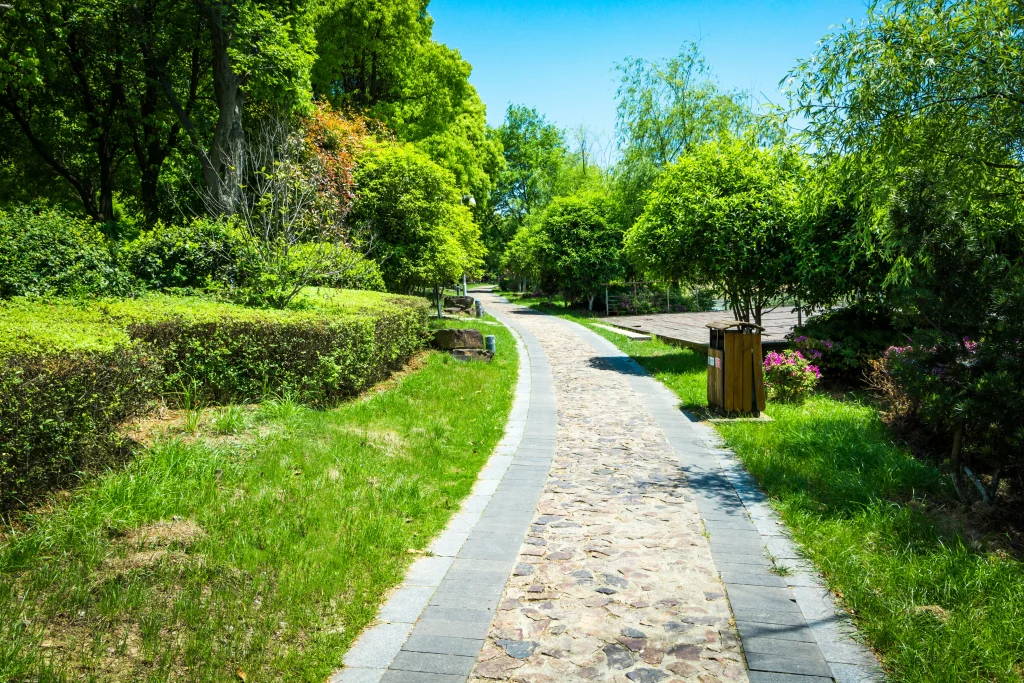Understanding different types of landscaping rocks becomes crucial for creating sustainable, attractive yards that thrive in Colorado’s demanding environment.
The right rock selection impacts water management, soil temperature regulation, and long-term maintenance costs. Poor choices lead to erosion, weed problems, and costly replacements. Smart choices create beautiful, functional landscapes that work with nature rather than against it.
This guide examines eight essential landscaping rock types perfect for Denver yards. You’ll discover their optimal applications, advantages, limitations, and specific considerations for Colorado’s freeze-thaw cycles.
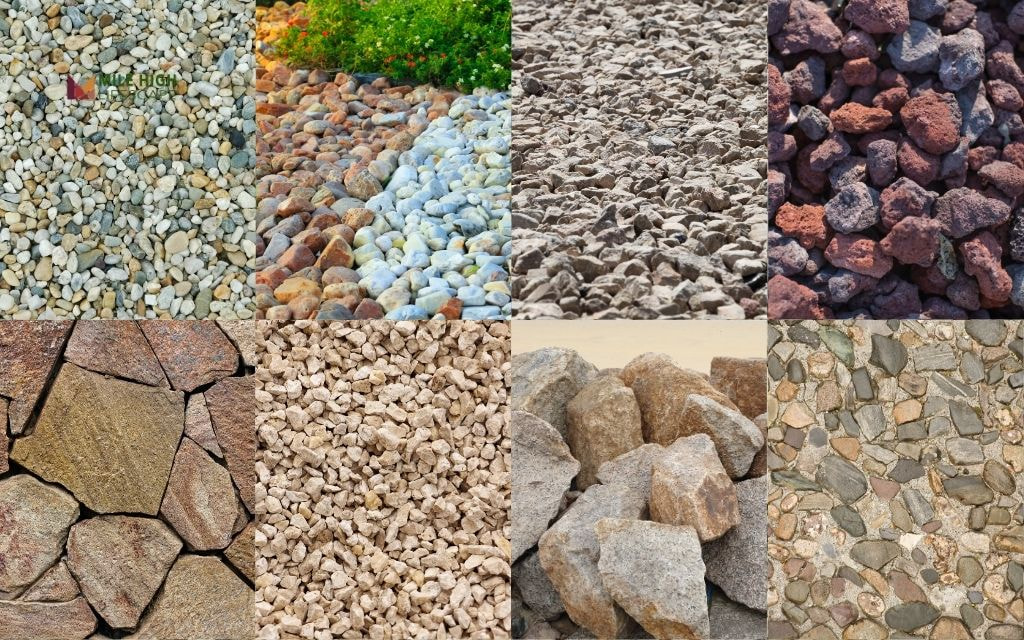
Pea Gravel
Pea gravel consists of small, rounded stones typically measuring ¼ to ⅜ inch in diameter. These smooth stones come in earth tones including tan, brown, gray, and cream.
The natural tumbling process creates comfortable surfaces that feel pleasant underfoot.
- Best Applications: Walkways, patio surfaces, drainage zones, and ground cover around plants. Pea gravel excels in areas requiring permeable surfaces that allow water infiltration while preventing mud formation.
- Advantages: Cost-effective option that installs quickly and requires minimal preparation. The rounded edges make it comfortable for bare feet, while the small size creates smooth, even surfaces. Excellent drainage properties prevent water pooling during Denver’s occasional heavy rains.
- Limitations: Without proper edging, pea gravel tends to migrate beyond intended boundaries. High-traffic areas may develop ruts or thin spots requiring periodic replenishment. Snow removal becomes challenging as gravel can scatter with shoveling.
- Denver-Specific Tip: Combine pea gravel with dry riverbeds to manage snowmelt runoff effectively. Use alongside organic mulch in planting beds to create attractive transitions between hardscape and softscape elements.
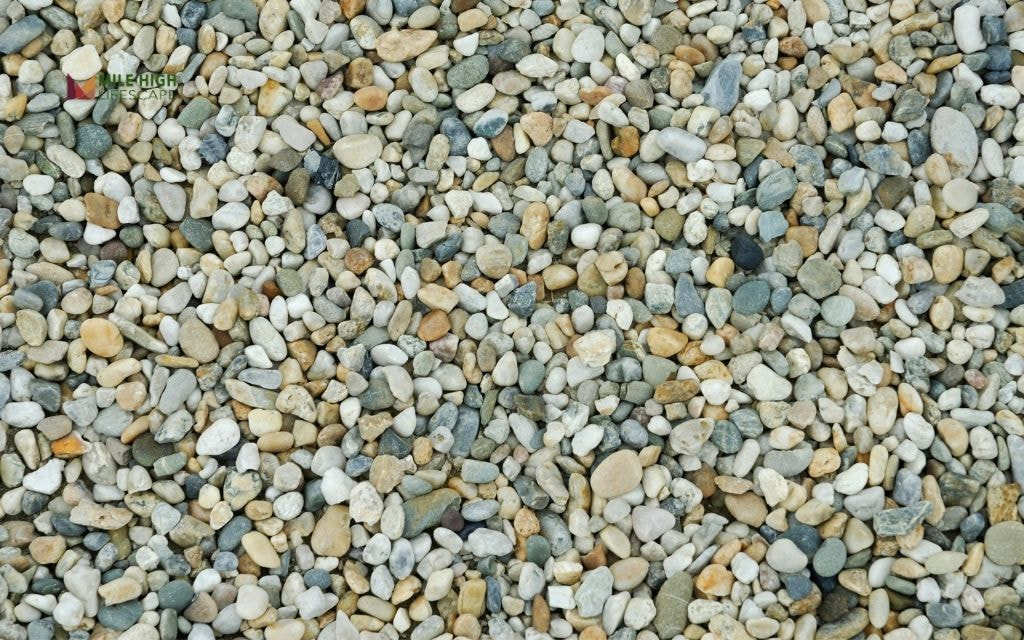
River Rock
River rock features smooth, oval-shaped stones ranging from 1 to 6 inches in diameter. Water action over centuries creates the characteristic rounded edges and polished surfaces.
Color variations include gray, brown, black, white, and mixed earth tones.
- Best Applications: Dry creek beds, border definitions, moisture retention around plants, and decorative accents. River rock works exceptionally well for creating natural-looking water features and drainage solutions.
- Advantages: Exceptional durability withstands Colorado’s harsh weather cycles without breaking down. The attractive appearance complements both modern and traditional landscape designs. Heavy weight provides stability in windy conditions common to the Front Range.
- Limitations: Higher material and installation costs compared to smaller gravel options. The weight requires more labor for installation and makes future modifications challenging. Large sizes can be difficult to walk on comfortably.
- Denver-Specific Tip: Position river rock strategically in sloped yards to control water flow during spring snowmelt. The stones help prevent soil erosion while creating attractive focal points in otherwise challenging terrain.

Crushed Granite
Crushed granite consists of angular, mechanically crushed stone particles ranging from fine dust to ¾-inch pieces. The angular edges allow particles to lock together when compacted, creating stable surfaces. Colors vary based on granite source but typically include gray, tan, and reddish tones.
- Best Applications: Pathways, driveways, xeriscaping projects, and areas requiring firm, stable surfaces. Crushed granite performs well in both formal and naturalistic landscape designs.
- Advantages: Compacts to form solid, stable surfaces ideal for foot and light vehicle traffic. The natural appearance blends with native Colorado landscapes.
- Limitations: Without adequate edging systems, material can gradually erode beyond intended boundaries. Fine particles may track onto adjacent surfaces during wet conditions. Requires occasional recompaction to maintain optimal surface integrity.
- Denver-Specific Tip: Use crushed granite in native plant beds requiring minimal irrigation. The material’s natural drainage properties support drought-tolerant plants while creating cohesive design themes throughout the landscape.
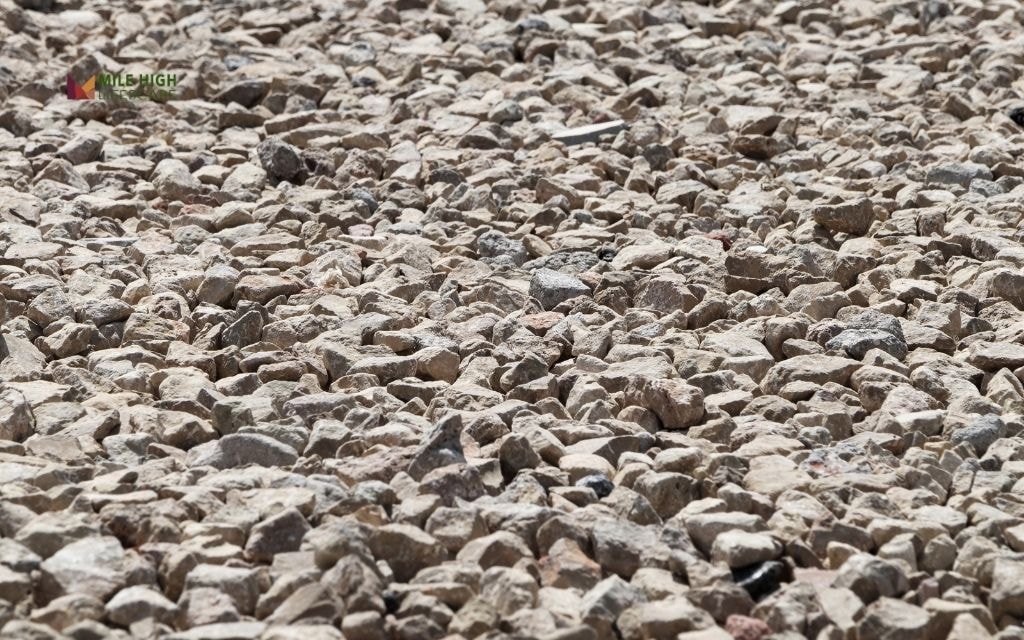
Lava Rock (Red & Black)
Lava rock originates from volcanic activity, creating porous, lightweight stones with distinctive textures. Available in two primary colors: deep black and rust red. The porous structure provides excellent insulation properties while maintaining low weight.
- Best Applications: Accent beds, xeriscaping projects, fire-safe mulch alternatives, and areas requiring lightweight fill material. Lava rock works particularly well around succulents and cacti.
- Advantages: Lightweight nature simplifies installation and reduces structural load on retaining walls or containers. Excellent insulation properties help regulate soil temperature during Colorado’s extreme weather. Fire-resistant characteristics provide safety benefits in wildfire-prone areas.
- Limitations: Sharp, porous surfaces make lava rock unsuitable for areas with foot traffic. The distinctive appearance may clash with certain architectural styles. Cost typically exceeds standard gravel options.
- Denver-Specific Tip: Replace traditional organic mulch with lava rock in fire-prone zones near buildings or property lines. The material provides plant protection while eliminating fire risk associated with combustible mulches.
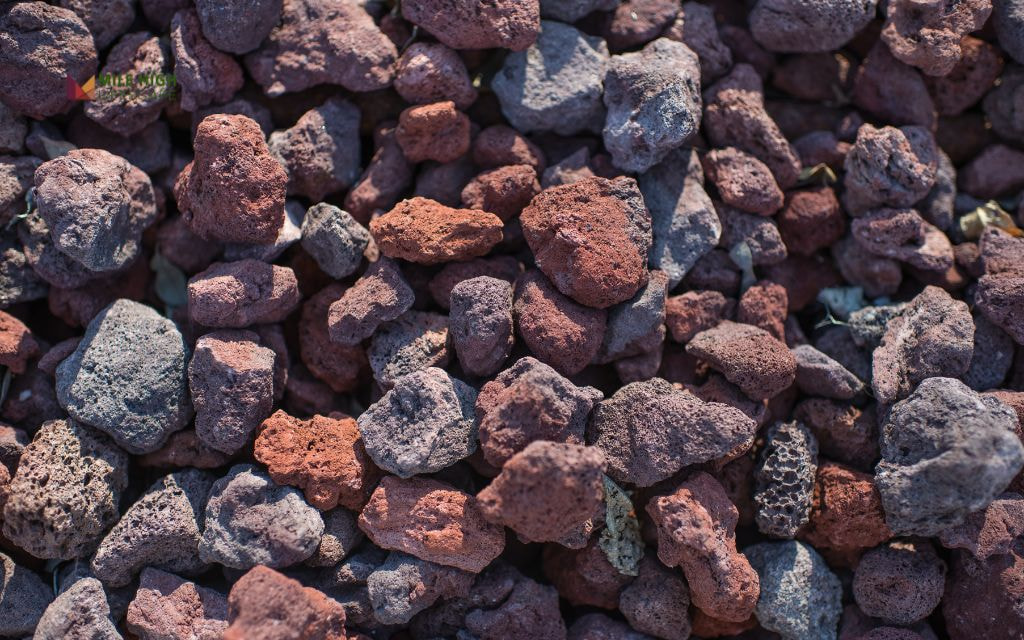
Flagstone
Flagstone comprises flat, naturally occurring rock slabs typically measuring 1 to 3 inches thick. Common materials include sandstone, slate, and limestone. Natural color variations range from gray and tan to red and purple, depending on mineral content and origin.
- Best Applications: Patio surfaces, stepping stone pathways, seating areas, and vertical accent walls. Flagstone creates elegant, functional surfaces suitable for outdoor entertainment and relaxation spaces.
- Advantages: Natural beauty and durability create long-lasting landscape features. Flat surfaces provide comfortable walking and seating areas. Heat absorption properties make flagstone comfortable even during hot summer days.
- Limitations: Premium material commands higher prices than other rock options. Installation requires careful base preparation to prevent settling and cracking. Natural variations in thickness demand skilled installation techniques.
- Denver-Specific Tip: Apply penetrating sealers to flagstone surfaces in areas prone to freeze-thaw cycles. Proper sealing prevents water infiltration that could cause cracking during winter months.
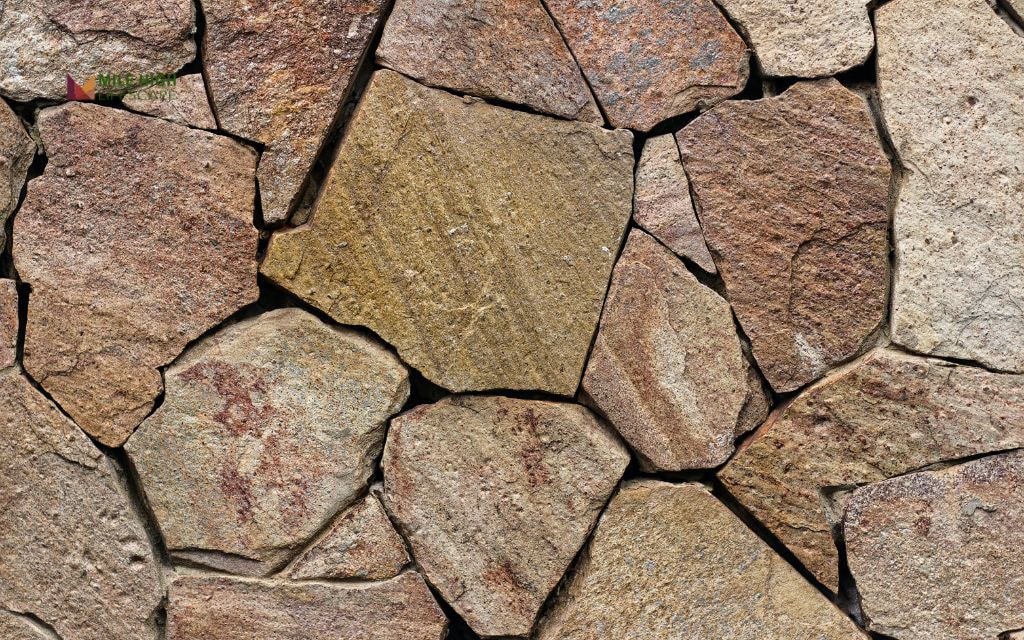
Decomposed Granite (DG)
Decomposed granite consists of granite rock broken down into fine particles ranging from sand-sized to ¼-inch pieces.
Natural weathering processes create this material, though commercial production involves mechanical crushing. Colors mirror parent granite: gray, tan, gold, and reddish hues.
- Best Applications: Low-traffic pathways, patio surfaces, Zen gardens, and areas requiring natural-looking, permeable surfaces. Decomposed granite works well for creating subtle transitions between different landscape zones.
- Advantages: Natural appearance blends seamlessly with native Colorado landscapes. Low cost makes it accessible for large-area applications. Compacts to form relatively stable surfaces while maintaining permeability.
- Limitations: Requires regular maintenance including recompaction and edge definition. Heavy rain or snow can cause surface erosion without proper stabilization. Fine particles may track onto adjacent surfaces.
- Denver-Specific Tip: Add polymer stabilizers to decomposed granite installations in areas experiencing regular snow and ice. Stabilization extends surface life during Colorado’s challenging winter conditions.
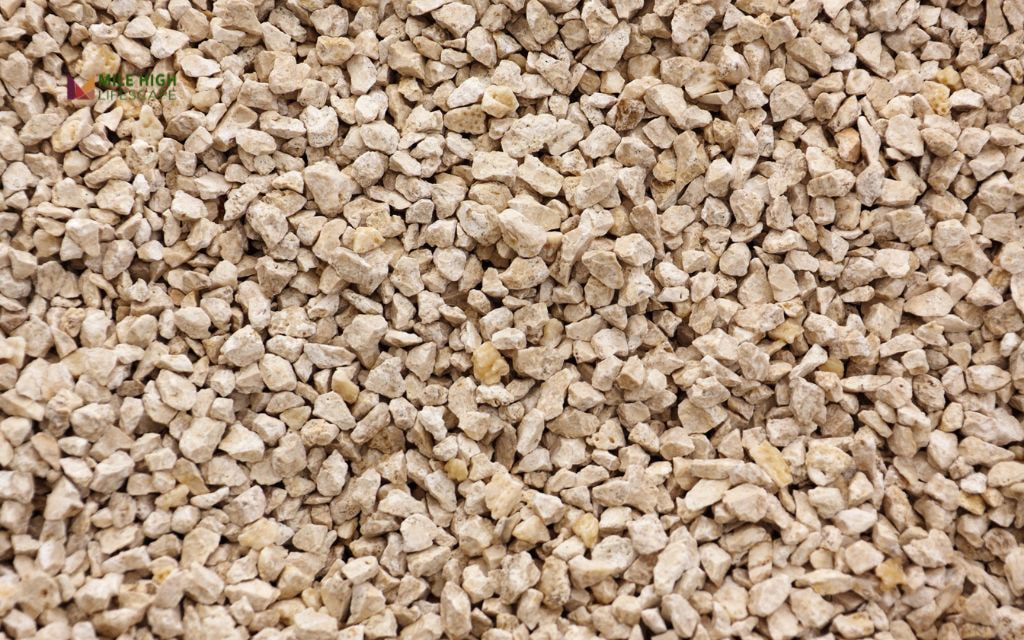
Boulders and Feature Rocks
Boulders encompass large rocks typically measuring 18 inches or greater in diameter. These substantial stones serve both functional and aesthetic purposes in landscape design. Materials include sandstone, granite, limestone, and locally quarried Colorado stone.
- Best Applications: Focal points, erosion control, retaining structures, and creating level changes in sloped terrain. Boulders work effectively for both dramatic design statements and practical engineering solutions.
- Advantages: Maximum visual impact creates instant landscape maturity. Zero ongoing maintenance requirements after proper installation. Excellent erosion control on slopes and in drainage areas.
- Limitations: Significant installation costs due to specialized equipment requirements. Weight and size make future relocation impractical. Limited availability of desirable specimens increases selection challenges.
- Denver-Specific Tip: Position boulders in terraced yards to create level planting areas for native gardens. The thermal mass helps moderate soil temperature fluctuations around plant roots.
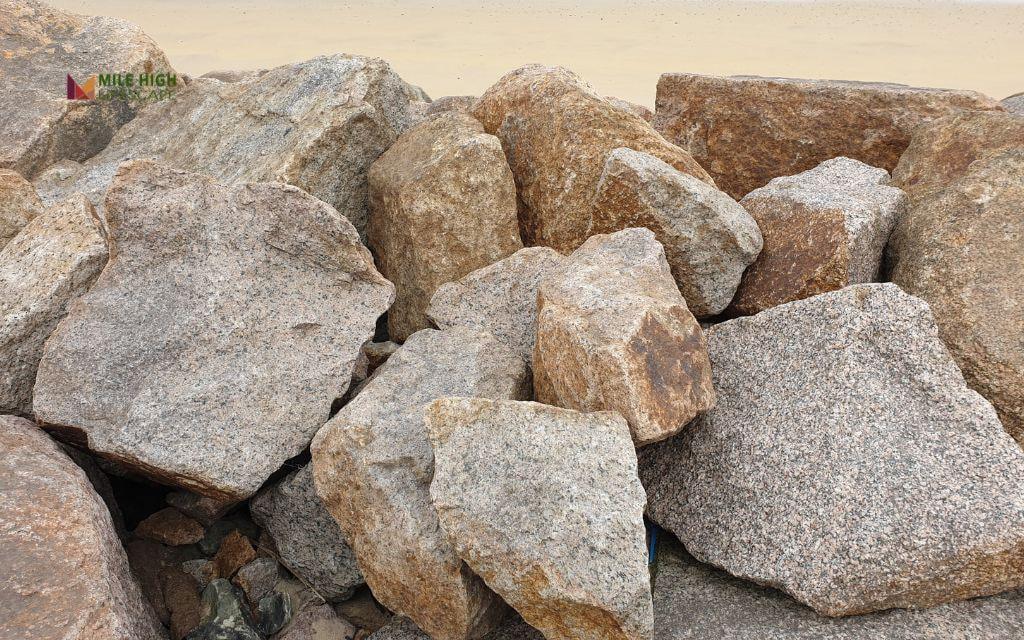
Cobblestone
Cobblestone consists of naturally rounded stones measuring 2 to 10 inches in diameter. Historical use in European street construction gives cobblestone distinctive character.
Modern landscape applications focus on decorative rather than structural uses.
- Best Applications: Border edging, water feature accents, and design elements requiring formal or old-world character. Cobblestone creates attractive transitions between different landscape materials.
- Advantages: Timeless aesthetic appeal complements various architectural styles. Exceptional durability withstands Colorado’s weather extremes. Rounded surfaces resist damage from freeze-thaw cycles.
- Limitations: Smooth surfaces become slippery when wet or icy. Higher costs compared to standard gravel options. Installation requires careful placement for optimal appearance.
- Denver-Specific Tip: Incorporate cobblestone to bridge formal hardscape elements with rustic native plantings. The material successfully unifies diverse design themes common in Denver’s varied architectural landscape.
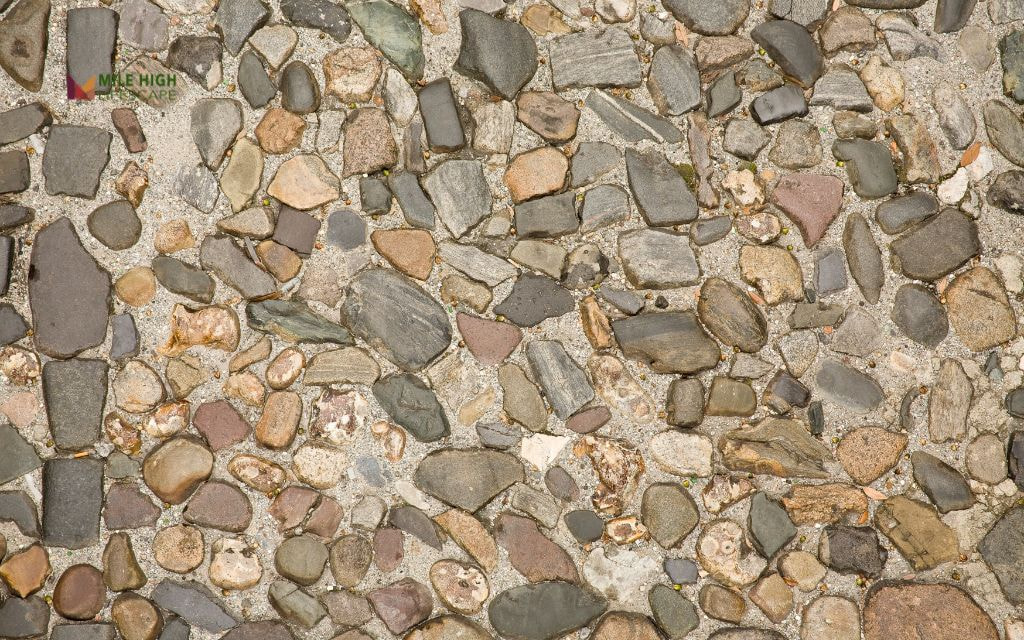
How to Choose Right Landscaping Rock Types for Your Yard
Successful rock selection depends on understanding your specific landscape needs. Consider primary usage patterns, drainage requirements, maintenance preferences, and aesthetic goals before making decisions.
- Pathway Applications (Prioritize comfort, stability, and longevity): Crushed granite and decomposed granite provide excellent walking surfaces, while flagstone offers premium aesthetics for high-visibility areas.
- Planting Bed Applications: Focus on drainage, weed suppression, and plant compatibility. Lava rock excels around drought-tolerant plants, while river rock provides attractive mulch alternatives in traditional gardens.
- Decorative Features: Emphasize visual impact and design cohesion. Boulders create dramatic focal points, while cobblestone adds refined detail to formal elements.
Additional factors affecting selection include water runoff patterns, existing soil conditions, HOA restrictions, and sun exposure levels. Combining multiple rock types often produces more dynamic, visually interesting landscapes than single-material approaches.
How Rock Type Affects Function, Cost, and Design Aesthetics
Understanding material properties helps optimize rock selection for Colorado’s challenging environment.
- Porosity affects drainage and freeze-thaw performance.
- Color influences heat absorption and visual compatibility.
- Weight impacts installation requirements and long-term stability.
| Rock Type | Appearance | Approx. Cost | Local Availability |
| Pea Gravel | Small, rounded, earth tones | Low | Excellent |
| River Rock | Smooth, oval, mixed colors | Medium | Good |
| Crushed Granite | Angular, natural gray/tan | Low-Medium | Excellent |
| Lava Rock | Porous, black/red | Medium-High | Good |
| Flagstone | Flat slabs, varied colors | High | Fair |
| Decomposed Granite | Fine particles, natural tones | Low | Good |
| Boulders | Large, dramatic | High | Fair |
| Cobblestone | Rounded, uniform | Medium-High | Fair |
- Functional Considerations: Freeze-thaw cycles demand materials that resist cracking and heaving. Porous rocks like lava stone handle temperature changes better than dense materials. Angular shapes provide better mechanical stability than rounded forms.
- Cost Factors: Material costs vary based on local availability, transportation distance, and processing requirements. Installation costs depend on equipment needs, site preparation, and labor intensity.
- Design Integration: Successful landscapes balance color temperature, texture contrast, and scale relationships. Warm-colored rocks complement adobe and stucco architecture, while cool grays suit contemporary designs.
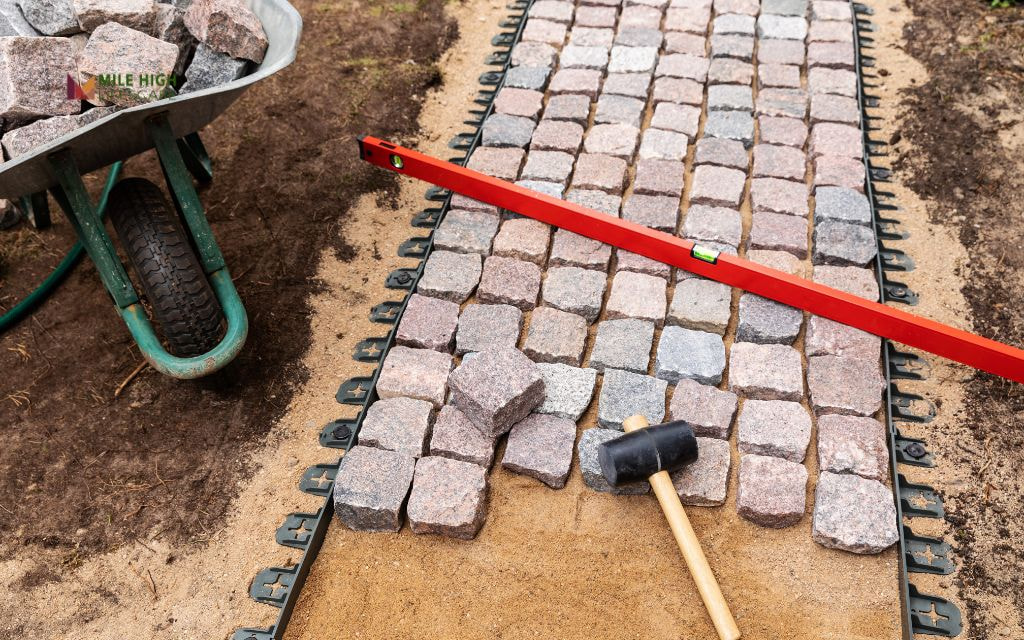
Maintenance Considerations by Rock Type
Different landscaping rock types require varying maintenance approaches to preserve appearance and functionality over time. Understanding these requirements helps inform selection decisions and budget planning.
- Weed Control: Fine materials like decomposed granite benefit from landscape fabric installation before rock placement. Larger materials allow weed suppression through proper depth application and periodic maintenance.
- Material Migration: Edging systems prevent rock migration beyond intended boundaries. Metal, concrete, or stone edging works effectively with most rock types. Regular inspection and maintenance preserve crisp landscape lines.
- Cleaning Requirements: Organic debris accumulation varies by rock type and surrounding vegetation. Smooth surfaces shed leaves and debris more easily than porous or angular materials.
- Weather Resistance: Colorado’s winds can move lighter materials like pea gravel and lava rock. Heavier options like river rock and boulders remain stable in most weather conditions.
- Snow Management: Consider snow removal methods when selecting pathway materials. Shoveling can scatter loose materials, while snow blowing works better with larger, stable rocks.
Conclusion
Selecting the right landscaping rock types creates sustainable Denver yards that thrive in Colorado’s climate. Each rock type serves specific functions while supporting water-wise principles.
Combining different types of rocks for landscaping maximizes both beauty and function. River rock manages drainage, crushed granite forms pathways, and boulders create focal points.
When searching for “rock landscapers near me,” choose professionals who understand Colorado’s unique demands. Mile High Lifescape delivers expert guidance and installation for lasting landscape success.
Transform your yard with landscaping rock types that work with Colorado’s climate while enhancing property value.
Frequently Asked Questions (FAQs)
What is the most low-maintenance landscaping rock?
River rock is the most low-maintenance option. Its weight prevents shifting, smooth surfaces resist debris buildup, and the material withstands Colorado’s freeze-thaw cycles without breaking down. Once installed with proper edging, river rock needs minimal attention for years.
Can I mix different types of rocks in one yard?
Yes, mixing rock types creates attractive, functional landscapes. Limit combinations to three types maximum and choose materials with similar color temperatures. Use large boulders as focal points, medium river rock for borders, and small pea gravel for pathways.
Are certain rock types better for xeriscaping?
Yes, crushed granite and lava rock work best for xeriscaping. These materials drain well, regulate soil temperature, and complement drought-tolerant plants perfectly. Decomposed granite also suits xeriscaping pathways.
How do I calculate how much rock I need?
Measure your area length × width × desired depth in feet, then divide by 27 for cubic yards. Apply 2-3 inches for decorative uses, 3-4 inches for walkways, and 4-6 inches for drainage. Add 10% extra for settling. Most suppliers provide calculators or professional estimates for accurate quantities.
Do landscaping rocks increase property value in Colorado?
Yes, quality rock landscaping typically increases property value by 70-100% of installation costs. Water-wise rock designs appeal strongly to Colorado buyers who value low maintenance and drought resistance. Professional installation with appropriate materials enhances curb appeal while reducing long-term yard care expenses.
